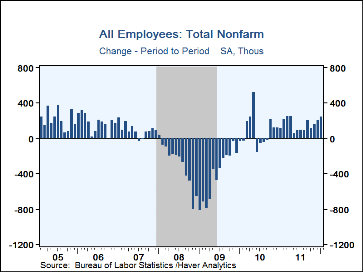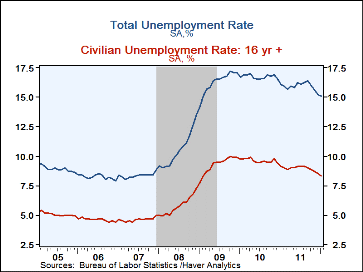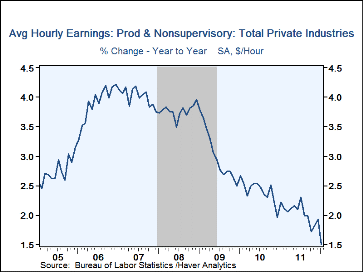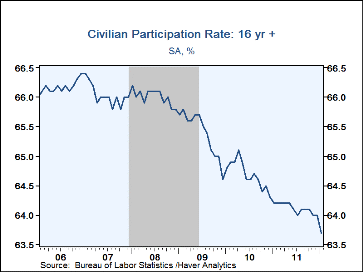 Global| Feb 03 2012
Global| Feb 03 2012U.S. Jobless Rate At 3-Year Low; Nonfarm Payrolls Jump
by:Tom Moeller
|in:Economy in Brief
Summary
Job market improvement picked up steam last month. From the household employment survey, the unemployment rate fell to 8.3%, continuing a decline which started after its late-2009 peak of 10.0%. Nonfarm payrolls grew 243,000 during [...]
Job market improvement picked up steam last month. From the household employment survey, the unemployment rate fell to 8.3%, continuing a decline which started after its late-2009 peak of 10.0%. Nonfarm payrolls grew 243,000 during January. Earlier figures were revised up. Factory sector payroll improvement continued on its recently stronger growth track. Private services again were firm but government payrolls fell further.
The unemployment rate fell last month to 8.3%. The decline
from 8.5% in December was to its lowest level in three years. It also
outpaced Consensus expectations for m/m stability at 8.5%. The rate
including marginally attached and those involuntarily part-time fell
to 15.1%. These declines reflected a sizable 631,000 increase in employment,
its strongest since November 2007. [This month-to-month figure includes an
adjustment for the effect of changing the benchmark for these labor force data
to the Census 2010 population base from the Census 2000 base.] The labor force
participation rate was 63.7%, its lowest since 1983. The average duration of
unemployment fell to 40.1 weeks, its lowest since October. The number unemployed for
more than 52 weeks fell to its lowest since June 2010.
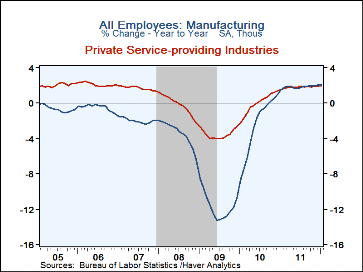
The 243,000 worker increase in January nonfarm payrolls followed a little-revised 203,000 December rise. The rise beat expectations for a 155,000 increase. Moreover, revisions to 2011 figures raised the annual growth rate to 1.2% from 1.0% reported earlier. Recent improvement in the factory sector picked up steam. The 50,000 increase in jobs last month left the y/y increase at 2.0%, its strongest since 1995. Growth in construction jobs of 2.1% y/y was its strongest since late-2006. Private service sector jobs rose 176,000 and followed similar gains in the last twelve months. Professional & business service sector growth of 3.5% this past year has been followed by leisure & hospitality (2.7% y/y) and education & health services (2.0% y/y). Financial industry employment (0.3% y/y) and information jobs (-1.7% y/y) remain under pressure. In the public sector, a 14,000 (-1.2% y/y) worker decline reflected an 11,000 (-1.1% y/y) drop in local hiring. Federal government hiring fell 6,000 (-1.5% y/y) and state government rose 3,000 (-1.4% y/y).
Further suggesting improvement in the labor market was the length of the average workweek. It was stable m/m at 34.5 hours but that was its highest since July of 2008. The latest figure was up from the recession low of 33.8 hours.
Somewhat offsetting the strength of the payroll jobs rise was the breath of its improvement. Sixty-four percent of industries reported one-month job gains. That's up from December but still below the Q1 average of 65.5%. The three-month figure of 62.2% has been steady since Q3 and down from Q1 of 66.2%. The factory sector has similar performance. Also suggestive of only moderate job market improvement was the minimal 0.1% uptick in average hourly earnings. The uptick left the y/y increase at 1.5%, a record low.
The figures referenced above are available in Haver's USECON database. Additional detail can be found in the LABOR and in the EMPL databases. The expectation figures are from Action Economics and are in the AS1REPNA database.
Employment Dynamics During Economic Recoveries from the Federal Reserve Bank of St. Louis can be found here.
| Employment: (M/M Chg., 000s) | Jan | Dec | Nov | Y/Y | 2011 | 2010 | 2009 |
|---|---|---|---|---|---|---|---|
| Payroll Employment | 243 | 203 | 157 | 1.5% | 1.2% | -0.7% | -4.4% |
| Previous | -- | 200 | 100 | -- | -- | -- | -- |
| Manufacturing | 50 | 32 | 3 | 2.0 | 1.8 | -2.7 | -11.6 |
| Construction | 21 | 31 | 1 | 2.1 | -0.2 | -8.2 | -16.0 |
| Private Service Producing | 176 | 149 | 179 | 2.0 | 1.8 | -0.1 | -3.5 |
| Government | -14 | -17 | -21 | -1.2 | -1.7 | -0.3 | 0.2 |
| Average Weekly Hours - Private Sector | 34.5 | 34.5 | 34.4 | 34.3 (Jan.'11) |
34.4 | 34.1 | 33.9 |
| Average Hourly Earnings (%) | 0.1 | 0.1 | 0.1 | 1.5 | 2.0 | 2.4 | 3.0 |
| Unemployment Rate(%) | 8.3 | 8.5 | 8.7 | 9.1 (Jan.'11) |
9.0 | 9.6 | 9.3 |
Tom Moeller
AuthorMore in Author Profile »Prior to joining Haver Analytics in 2000, Mr. Moeller worked as the Economist at Chancellor Capital Management from 1985 to 1999. There, he developed comprehensive economic forecasts and interpreted economic data for equity and fixed income portfolio managers. Also at Chancellor, Mr. Moeller worked as an equity analyst and was responsible for researching and rating companies in the economically sensitive automobile and housing industries for investment in Chancellor’s equity portfolio. Prior to joining Chancellor, Mr. Moeller was an Economist at Citibank from 1979 to 1984. He also analyzed pricing behavior in the metals industry for the Council on Wage and Price Stability in Washington, D.C. In 1999, Mr. Moeller received the award for most accurate forecast from the Forecasters' Club of New York. From 1990 to 1992 he was President of the New York Association for Business Economists. Mr. Moeller earned an M.B.A. in Finance from Fordham University, where he graduated in 1987. He holds a Bachelor of Arts in Economics from George Washington University.


